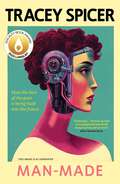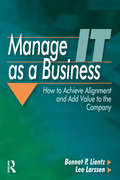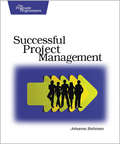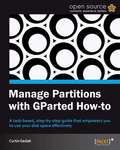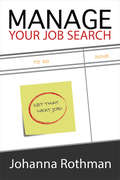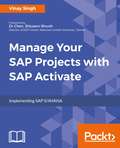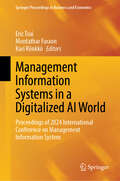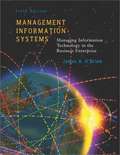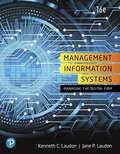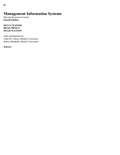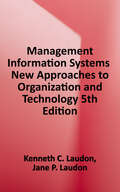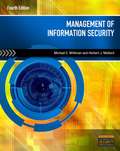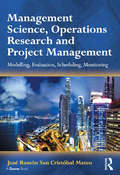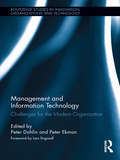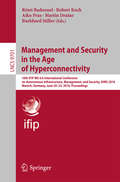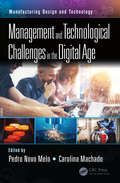- Table View
- List View
Man-Made: How the bias of the past is being built into the future
by Tracey SpicerWalkley Award-winning journalist Tracey Spicer exposes the next frontier of feminism. Man-Made aims to open readers&’ eyes to a transformative technological shift in society and give them the tools to make positive change. `Mum, I want a robot slave.&’ Broadcaster Tracey Spicer had an epiphany when her young son uttered these six words. Suddenly, her life&’s work fighting inequality seemed futile. What&’s the point in agitating to change the present, if bigotry is being embedded into our futures? And so began a quest to uncover who was responsible and hold them to account. Who is the ultimate villain? Big Tech, whose titans refuse to spend money to fix the problem? The world&’s politicians, who lack the will to legislate? Or should we all be walking into a hall of mirrors and taking a good, hard look at ourselves…? This is a deeply researched, illuminating and gripping ride into an uncertain future, culminating in a resounding call to action that will shake the tech sector to its foundations.Praise for Man-Made &‘Exhilarating … The book we need as we grapple with how AI will change our lives and our world.&’ Dame Quentin Bryce &‘Brilliant, hilarious and terrifying. You&’ll never see Alexa the same way again.&’ Juanita Phillips &‘Tracey Spicer uses her unmistakably human voice to warn us all about the deeply sexist Frankenstein&’s Monster that is modern AI.&’ Yumi Stynes
Manage IT as a Business: How To Achieve Alignment And Add Value To The Company
by Bennet Lientz Lee LarssenMany IT projects fail to deliver the benefits to the business that were promised. Yet IT managers and staff work hard to meet the needs of the business: Systems are put in place; network operations are reliable and stable. The cause is usually a misalignment of IT with the business. In this book, Bennet Lientz and Lee Larssen present over 200 specific, practical guidelines and steps that show how to: align IT and the business, develop methods that make IT more proactive in helping the business, more effectively manage vendors, avoid negative surprises, ensure that more projects are completed on time and within budget, among other things. The techniques in this book have been implemented in over 60 organizations around the world and in over 20 different industries, and the authors include several examples in each chapter to illustrate their points. Follow these proven recommendations to manage IT as a business that adds value to the company.
Manage It!: Your Guide to Modern, Pragmatic Project Management
by Johanna RothmanThis book is a reality-based guide for modern projects. You'll learn how to recognize your project's potholes and ruts, and determine the best way to fix problems - without causing more problems.Your project can't fail. That's a lot of pressure on you, and yet you don't want to buy into any one specific process, methodology, or lifecycle.Your project is different. It doesn't fit into those neat descriptions.Manage It! will show you how to beg, borrow, and steal from the best methodologies to fit your particular project. It will help you find what works best for you and not for some mythological project that doesn't even exist.Before you know it, your project will be on track and headed to a successful conclusion.
Manage Partitions with GParted How-to
by Curtis GedakThis book is a practical, task-based, step-by-step tutorial that starts simple with identifying disk device partitions, and culminates with advanced tasks such as preparing for new operating systems. Are you a computer enthusiast who is looking forward to learn how to effectively use your disk space through disk partitions to maximize your computer's potential? Then this book is for you.
Manage Software Testing
by Peter Farrell-VinayWhether you are inheriting a test team or starting one up, Manage Software Testing is a must-have resource that covers all aspects of test management. It guides you through the business and organizational issues that you are confronted with on a daily basis, explaining what you need to focus on strategically, tactically, and operationally. Using a
Manage Your Job Search
by Johanna Rothman"A job search is an emergent project. How do you handle an emergent project? By creating a system that allows for serendipity and flexibility: personal kanban and one-week timeboxes.Once you have a system, you can use the tips in Part 2 to prepare for your job search: choose your career, write your resume, prepare for your interviews, and decide how you will decide on an offer. In Part 3, you'll learn how to network without feeling slimy. You'll learn to build your target network, where to look for the jobs that you need, and how to spot the warning signs of a job that organizations might no longer need. There are many traps for unsuspecting job hunters, so Part 4 has a section on traps to avoid and tips to try. If you're in special circumstances, such as being a new grad, in a career transition, or over 50, then Part 5 is for you. Even if you've been diligent, any job search can take more than three months. Part 6 addresses your feelings and how to persevere when your search seems as if it takes forever.Written with her trademark practicality, humor, and empathy, Johanna will help you learn how to find your next job.This book was written and produced entirely by the author. We are proud to be distributing it."
Manage Your Life with Outlook For Dummies
by Greg HarveyAn all-new guide that unlocks the secrets of greater Office 2007 productivity-a must-have for power users and everyone who would like to work more efficiently Offers scores of tips, tricks, and techniques to boost productivity with the programs people use every day-Word, Outlook, Excel, and PowerPoint Topics covered include dealing effectively with e-mail, effectively managing files, using and creating templates, reusing and remixing content, sharing and reviewing content, and efficiently managing time and scheduling The CD-ROM and companion Web site offer podcasts of key productivity tips from the book Note: CD-ROM/DVD and other supplementary materials are not included as part of eBook file.
Manage Your Own Learning Analytics: Implement a Rasch Modelling Approach (Smart Innovation, Systems and Technologies #261)
by Elspeth McKayThis book sheds light on the practice of learning analytics, illuminating how others approach their data analysis. At the beginning of the book, a ‘prescriptive learning analytics planning model’ gives straightforward instructions for people to follow. This book is organized into ten chapters, falling into four topical sections: Managing Learning Analytics (overview, instructional systems design (ISD), instructional design, and planning data analysis); Cognitive Performance Measurement Practices (classical test theory (CTT), Rasch measurement theory (RMT), Item response theory(IRT), Rasch Modeling Tools (research design, setting methodology); and Case Studies (corporate training settings, healthcare industry, and educational courseware design). This book is an important reference for: educational research community and instructional systems designers; corporate training developers; postgraduate course developers; and doctoral students.
Manage Your Project Portfolio: Increase Your Capacity and Finish More Projects
by Johanna RothmanYou have too many projects, and firefighting and multitasking are keeping you from finishing any of them. You need to manage your project portfolio. This fully updated and expanded bestseller arms you with agile and lean ways to collect all your work and decide which projects you should do first, second, and never. See how to tie your work to your organization's mission and show your managers, your board, and your staff what you can accomplish and when. Picture the work you have, and make those difficult decisions, ensuring that all your strength is focused where it needs to be. All your projects and programs make up your portfolio. But how much time do you actually spend on your projects, and how much time do you spend on emergency fire drills or waste through multitasking? This book gives you insightful ways to rank all the projects you're working on and figure out the right staffing and schedule so projects get finished faster.The trick is adopting lean and agile approaches to projects, whether they're software projects, projects that include hardware, or projects that depend on chunks of functionality from other suppliers. Find out how to define the mission of your team, group, or department, with none of the buzzwords that normally accompany a mission statement. Armed with the work and the mission, you'll manage your portfolio better and make those decisions that define the true leaders in the organization. With this expanded second edition, discover how to scale project portfolio management from one team to the entire enterprise, and integrate Cost of Delay when ranking projects. Additional Kanban views provide even more ways to visualize your portfolio.
Manage Your SAP Projects With SAP Activate
by Vinay SinghExplore and use the agile techniques of SAP Activate Framework in your SAP Projects. About This Book • Explore the three pillars of SAP Activate and see how it works in different scenario. • Understand and Implement Agile and Scrum concepts in SAP Activate. • Get to Grisp with SAP Activate framework and manage your SAP projects effectively. Who This Book Is For This book is for readers who want to understand the working of SAP Activate and use it to manage SAP projects. Prior knowledge of SAP Hana is must. What You Will Learn • Understand the fundamentals of SAP S4/HANA. • Get familiar with the structure and characteristics of SAP Activate. • Explore the application scenarios of SAP Activate. • Use Agile and Scrum in SAP Projects effectively and efficiently • Implement your learning into a sample project to explore and understand the benefits of SAP Activate methodology. In Detail It has been a general observation that most SAP consultants and professionals are used to the conventional waterfall methodology. Traditionally, this method has been there for ages and we all grew up learning about it and started practicing it in real world. The evolution of agile methodology has revolutionized the way we manage our projects and businesses. SAP Activate is an innovative, next generation business suite that allows producing working deliverables straight away. Manage your SAP Project with SAP Activate, will take your learning to the next level. The book promises to make you understand and practice the SAP Activate Framework. The focus is to take you on a journey of all the phases of SAP Activate methodology and make you understand all the phases with real time project examples. The author explains how SAP Activate methodology can be used through real-world use cases, with a comprehensive discussion on Agile and Scrum, in the context of SAP Project. You will get familiar with SAP S4HANA which is an incredibly innovative platform for businesses which can store business data, interpret it, analyze it, process it in real time, and use it when it's needed depending upon the business requirement. Style and approach An easy to follow approach with concepts explained via scenarios and project examples
Management Control System in Smart and Sustainable Firms: A Theoretical Analysis from an Ecosystem Perspective (SIDREA Series in Accounting and Business Administration)
by Domenica LavoratoIn today's competitive environment, smart technologies are increasingly recognized as key enablers of corporate sustainability. In this new context, corporate management control systems integrate with the issues of smart technologies, sustainability and inter- and intra-organizational collaboration as the driving elements of the firm of the future. This book proposes a management control framework for today's firms. It investigates the effectiveness of traditional management control systems in today’s competitive environment and identifies potential limitations that may hinder their ability to effectively monitor modern organizations. Furthermore, the book explores whether these systems can be improved with complementary tools or if entirely new mechanisms are required. The book argues the need to adopt a new approach to control and a different lens for evaluating the activity of guiding the achievement of corporate objectives, paving the way for the conceptualization of a new management control system.
Management Information Systems in a Digitalized AI World: Proceedings of 2024 International Conference on Management Information System (Springer Proceedings in Business and Economics)
by Eric Tsui Montathar Faraon Kari RönkköThis proceedings volume covers peer-reviewed papers of the 2nd International Conference on Management Information System which is held on Sept 28–30, 2024, in Tokyo, Japan. In an increasingly digitalized and connected world, management information systems are no longer serving resource planning, monitoring and reporting purposes. Indeed with the increasing availability of data from new sources, machine learning and artificial intelligence software can enable more automations involving less human decision-making and interventions, as well as generate predictions which can, among others, enhance risk prevention and astuteness in crisis management. This volume is valuable in introducing and explaining the impact of Industry 4.0, generative artificial intelligence, metaverse and others on organizational management information systems. Latest research and case studies are covered.
Management Information Systems: Managing Information Technology in the Business Enterprise (6th edition)
by James A. O'BrienThis book will be very much useful for business students who must be conversant with the tools of MIS to become successful managers and entrepreneurs. Students learn how Information Technology provides them with a powerful managerial resource that can help manage business operations, make better decisions, and gain competitive advantages.
Management Information Systems: Managing the Digital Firm
by Kenneth C. Laudon Jane P. LaudonThis book provides the most comprehensive overview of information systems used by business firms today, while drawing connections between MIS and business performance. <p><p> The Laudons are known for their outstanding real-world case studies, which describe how well-known companies use IT to solve problems and achieve business objectives. Students develop sought-after skills, such as leading IS-related management discussions and using IT to meet bottom-line results. <p><p> Each chapter of the 16th edition features all-new Interactive Sessions, new Video Cases, and a new Career Opportunities section building practical job-seeking skills.
Management Information Systems: Moving Business Forward
by R. Kelly Rainer Brad Prince Hugh J. WatsonThe 4th Edition of Management Information Systems promotes active learning like no other text in the market. Each chapter is comprised of tightly coupled concepts and section-level student activities that transport your students from passively learning about IS to doing IS in a realistic context. The integration of Microsoft Excel and Access exercises at the end of every chapter enables students to practice their Microsoft application skills in the context of the chapter material.
Management Information Systems: New Approaches to Organization and Technology
by Kenneth C. Laudon Jane P. LaudonDescribing the interconnections between technology, the organization, and IS management, this book provides a coverage of the Internet and focuses on how it is transforming the way firms conduct business. A chapter introduces business processes with a discussion of how they can impact the redesign of an organization to be more competitive.
Management Innovation and Big Data (Management for Professionals)
by Yan Li Zheng Qin Yinzhou YangAdhering to the combination of theoretical introduction and practical case introduction, this book summarizes the basic concepts and methods in management and big data analysis at home and abroad and introduces a large number of relevant practical cases, especially new cases in the Internet era, to help readers integrate theoretical knowledge into practical applications. The chapters of this book are interrelated and independent of each other, making it easy for the reader to study in pieces or to delve deeper into a particular topic of interest. Covering an array of theories about management and big data at home and abroad, this book lays a solid foundation for being an authentic manager. It is organized into sections on decision-making, organization, leadership, control, innovation, and big data to fully dissect and summarize the basic concepts of these characters in management and to show the basic methods that managers can use to solve problems. Each section contains a large number of examples to demonstrate how entrepreneurs successfully manage their large companies and overcome the difficulties in the business, utilizing the corresponding management functions or big data technology. Further, in order to adapt to the development of the Internet era, this book also absorbs a lot of practice cases of management innovation and big data which have emerged in recent years based on advanced network platform and big data analysis. This book puts great emphasis on the innovative function of management, adding more comprehensive methods and more updated cases related to the Internet.
Management Of Information Security (Fourth Edition)
by Michael E. Whitman Herbert J. MattordMANAGEMENT OF INFORMATION SECURITY, Fourth Edition gives readers an overview of information security and assurance using both domestic and international standards, all from a management perspective. Beginning with the foundational and technical components of information security, this edition then focuses on access control models, information security governance, and information security program assessment and metrics. The Fourth Edition is revised and updated to reflect changes in the field, including the ISO 27000 series, so as to prepare readers to succeed in the workplace.
Management Perspective for Transport Telematics: 18th International Conference on Transport System Telematics, TST 2018, Krakow, Poland, March 20-23, 2018, Selected Papers (Communications in Computer and Information Science #897)
by Jerzy MikulskiThis book constitutes the thoroughly refereed proceedings of the 18th International Conference on Transport Systems Telematics, TST 20187, held in Krakow, Poland in March 2018.The 36 full papers presented in this volume were carefully reviewed and selected from 128 submissions. They present and organize the knowledge from within the field of telematics in road transport, in rail transport, in marine transport, in air transport, in logistics.
Management Science, Operations Research and Project Management: Modelling, Evaluation, Scheduling, Monitoring
by José Ramón MateoDue to its societal and economic relevance, Project Management (PM) has become an important discipline and a concept critical to modern organizations, public and private. PM as an academic discipline is discussed both in Management Science and in Operations Research. Management Science tends to focus on quantitative tools and the soft skills necessary to manage projects successfully. Operations Research gives the essential scientific contribution to the success of project management through the development of models and algorithms. In Management Science, Operations Research and Project Management, José Ramón San Cristóbal Mateo fills the gap between scientific research and the practical application of that research. Project managers need formal training in decision-making but sometimes, they do not have an in-depth knowledge of Operations Research or they lack the necessary theoretical background. This book, with its focus on the quantitative models of Operations Research and Management Science applied to Project Management, provides project managers with the tools and methods necessary to manage projects successfully. Project managers operate in a complex global environment, in which numerous factors need to be considered, such as minimizing total project costs, meeting contracted dates, and ensuring that activities achieve certain quality levels. The focus here on the application of quantitative models of Operations Research and Management Science applied to Project Management provides them with the tools and methods necessary to make sound decisions.
Management and Information Technology after Digital Transformation (Routledge Studies in Innovation, Organizations and Technology)
by Peter Dahlin Peter Ekman Christina KellerWith the widespread transformation of information into digital form throughout society – firms and organisations are embracing this development to adopt multiple types of IT to increase internal efficiency and to achieve external visibility and effectiveness – we have now reached a position where there is data in abundance and the challenge is to manage and make use of it fully. This book addresses this new managerial situation, the post-digitalisation era, and offers novel perspectives on managing the digital landscape. The topics span how the post-digitalisation era has the potential to renew organisations, markets and society. The chapters of the book are structured in three topical sections but can also be read individually. The chapters are structured to offer insights into the developments that take place at the intersection of the management, information systems and computer science disciplines. It features more than 70 researchers and managers as collaborating authors in 23 thought-provoking chapters. Written for scholars, researchers, students and managers from the management, information systems and computer science disciplines, the book presents a comprehensive and thought-provoking contribution on the challenges of managing organisations and engaging in global markets when tools, systems and data are abundant.
Management and Information Technology: Challenges for the Modern Organization (Routledge Studies in Innovation, Organizations and Technology)
by Lars Engwall Peter Dahlin Peter EkmanInformation technology has come to play an important role in organizations over the last few decades. Though it began as an entity dealt with by specialists, IT has evolved to become an everyday tool with both operational and strategic impacts. Most modern organizations have adopted different forms of IT, and become dependent on their computer-based information systems and their peripherals for everyday operations. Information technology offers opportunities to increase efficiency, customer value, and competitiveness. Given the financial investment in IT required by organizations to remain competitive, IT has become a resource that needs to be managed. Management and Information Technology evaluates organizations’ utilization of IT including knowledge management and e-learning, accounting, and business relationships. Presenting theories to help the reader understand the varying roles IT can occupy in different organizations, this volume illustrates the ways in which IT has become a key strategic tool.
Management and Security in the Age of Hyperconnectivity
by Rémi Badonnel Robert Koch Aiko Pras Martin Drašar Burkhard StillerThis book constitutes the refereed proceedings of the 10th IFIP WG 6. 6 International Conference on Autonomous Infrastructure, Management, and Security, AIMS 2016, held in Munich, Germany, in June 2016. The 7 full papers presented together with 3 short papers were carefully reviewed and selected from 22 submissions. The volume also includes 9 papers presented at the AIMS PhD workshop. They were reviewed in a separate process and selected from 21 submissions. The full papers are organized in topical sections on autonomic and smart management and security attacks and defenses. The workshop papers are organized in topical sections on management of future networks and security management. The short papers deal with methods for management and security.
Management and Sustainability in the Belt and Road
by Andrew W. H. Ip Lianne K. W. LamChina’s Belt and Road Initiatives (BRI) is an ambitious infrastructure project conceived in 2013 by President Xi Jinping with development and investment initiatives stretching from Asia and Europe that reflect the original Silk Road with business networks through countries such as Afghanistan, Kazakhstan, Kyrgyzstan, Tajikistan, Turkmenistan, and Uzbekistan, as well as India and Pakistan, spanning a route of more than 4,000 miles and history that can be dated back more than 2,200 years. Given the background of China’s unique approach in fighting COVID-19, and against the backdrop of sluggish economic growth, innovation, and management, sustainable development of BRI will be the key and the driving force for the post-pandemic economic recovery of many countries, especially as BRI countries now account for nearly 30% of China’s foreign trade and 15% of outward direct investment. The vision to create a vast network of railways, energy pipelines, highways, and streamlined border crossings to expand the international use of Chinese currency and improve connectivity to China is good foresight and proved fortuitous when the COVID-19 pandemic came to plague the world, and amid the conflicts between the United States and China as well as the war between Russia and Ukraine. Since the inception of BRI, many books have been written to cover topics ranging from globalization to detailing how China’s business and politics are a major motivation for China’s overseas economic activities with case studies and practices, yet few of these books provide a structured approach to the sustainable management of BRI projects. This book is about how to manage the innovation, sustainability, and business necessary to make BRI work and how to handle the issues, problems, and crises that may arise in the process. Participants of BRI projects can take on many different roles, but ultimately, it is team effort and leadership that creates successful projects. Here, readers will find guidelines and insights to survive and prosper in a myriad of BRI opportunities and risks. Most important of all, this book provides a glimpse of different approaches for success in BRI projects, including sustainability, environmental issues, social and political aspects, technology, choice of industry, project management, education and training, governance, and many more.
Management and Technological Challenges in the Digital Age (Manufacturing Design and Technology)
by Carolina Machado Pedro Novo MeloBusinesses operate amid a digital age, and unsurprisingly, technology has engendered tools that now predominate all corners of the workplace. The ascendancy of new hardware and software poses new challenges for professionals in the field of management and human resources as corporations and companies routinely implement and incorporate digital software for goals such as improving worker productivity and tasks such as screening highly qualified candidates for vacancies. In the face of rapid change, professionals must investigate how the use of digital technology affects the culture of hiring processes, employee morale, company management, and corporate image. This book aims to promote research related to these new trends and open a new field within the areas of management and engineering. Through the course of nine chapters, contributors to Management and Technological Challenges in the Digital Age grapple with the theoretical and practical implications that technological usage carries across the range of small and large organizations in the world of business. <li>Focuses on the latest research findings that are occurring in this field in different countries <li>Shows how companies around the world are facing today's technological challenges <li>Shares knowledge and insights on an international scale <li>Keeps the readers and researchers informed about the latest developments in the field and forthcoming international studies <li>Explains how the use of technology allows management to take a more strategic role in organizations <P><P>This book affords a thorough engagement with the progresses and setbacks made through the enlistment of technological equipment and computerized procedures in the field of human resources and management while interrogating the future challenges of technology’s role.
